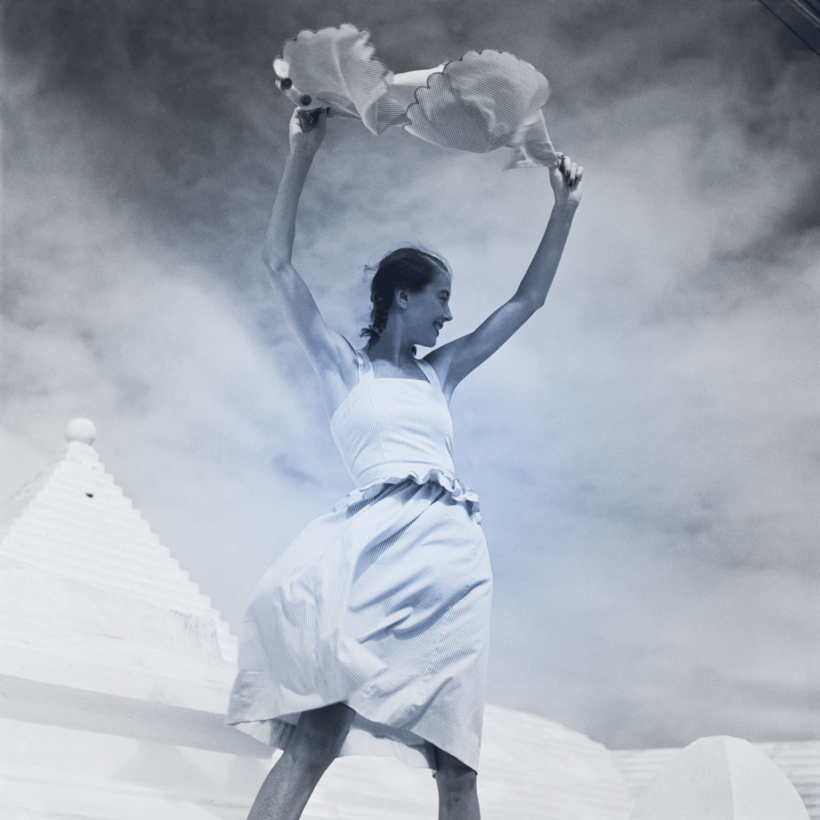In the 1950s, Claire McCardell was one of the most influential women in America. The New York–based fashion designer had become a household name by pioneering “the American Look”—casually elegant sportswear that was as beautiful as it was pragmatic. In the 1930s, McCardell created mix-and-match “separates,” a capsule wardrobe of six items, including pants, a skirt, and a halter top, that could be (as the name implies) mixed and matched into numerous outfits. Her concept of separates would go on to become the foundation of modern fashion. She partnered with Capezio, the storied manufacturer of dance shoes, in the 1940s to invent the modern ballet flat. She modernized the wrap dress, introduced hoodies and denim into women’s wear, put pockets on all her clothes, and boldly designed leggings at a time when women could still be arrested for wearing pants in public.
McCardell was the first ready-to-wear designer to get her name on her own label, and everyone wore her clothes, from housewives and career women to Hollywood stars such as Lauren Bacall, Greta Garbo, and Joan Crawford. When Calvin Klein was asked in 1981 who’d inspired him, he named McCardell. “She really invented sportswear, which is this country’s major contribution to fashion,” Klein said.
So I’ve always wondered why it is that McCardell’s name has been lost to history, even as we continue to wear what she created. I began researching her life and work several years ago for my book Claire McCardell: The Designer Who Set Women Free, and one day, while sifting through papers in her archive, I spotted a 1955 magazine profile. The headline read “The Gal Who Defied Dior.” The byline was equally intriguing: a young Betty Friedan had written the article, eight years before she published her book The Feminine Mystique. How, I wondered, had McCardell “defied” Christian Dior, the most renowned postwar French haute couturier?
What I uncovered is a riveting story of international fashion rivalries, misogynistic spats played out in the media, and a battle over women’s bodies. I came to understand that McCardell’s ingenious breakthroughs were about far more than fashion—they were about freedom.
McCardell had already been working in fashion for two decades when Dior opened his namesake atelier in Paris and launched his first collection, in 1947. Haute couture was trying to find its footing after World War II, and the French capital had high hopes for Dior. The designer said his goal was to “save women from nature,” and he constructed dresses and suits that dramatically shaped a body into an hourglass ideal. He cinched his models into corsets, aiming for an 18-inch waist, while amplifying shoulders, breasts, and hips with padding.
Dior’s inaugural collection, particularly the black-and-white Bar suit, is lauded today as a watershed moment in fashion history. But the suit was less beloved by the women who actually wore it. One American fashion editor compared Dior’s corset to a straitjacket, and she lasted less than 15 minutes before ripping it from her body. A former model complained loudly at a party that she couldn’t sit, walk, eat, or breathe in her Dior couture. The press dubbed his fashion “the New Look,” but McCardell saw it as a return to the old ways of manipulating a woman’s body into an object of male desire.
Still, many American manufacturers and designers began to copy Dior’s New Look. Not McCardell, though. She “ignored such nonsense,” as Friedan later wrote. McCardell became a voice of reason, going on radio and television shows to encourage women to ditch the corsets and the push-up bras. “It’s not intelligent to follow fashion blindly,” she said of the French trend, adding that “comfort should be a keynote of style.”
McCardell believed women should have clothes that celebrated their natural bodies while also supporting their lifestyles. A wardrobe should be in service to the woman, and not the other way around. “Men are free of the clothes problem,” as McCardell liked to say, so why shouldn’t women be free as well? She designed beautiful, well-constructed ready-to-wear that was also washable, easy to pack, and comfortable. Women began protesting Dior and his regressive designs, even picketing outside his hotel in Chicago when he visited the U.S. The designer thought it all wonderful publicity.
The New Look–versus–American Look rivalry took an acrimonious turn when Dior’s countryman the designer Jacques Fath declared in 1954 that women should stick to wearing clothes and quit making them. Among McCardell’s papers, I found her typewritten retort to Fath, and it’s a barn burner. “Ah, men,” she began, “they never understand the way clothes feel. Their lines are often harsh and masculine.... When [Coco] Chanel gave them soft feminine simplicity it was Chanel they loved.” McCardell continued to boldly defy the male-dictated fashion rules and to follow her creative instincts.
At the Met Gala this past May, the actor Monica Barbaro wore a modern interpretation of Dior’s original Bar suit. In June, the singer Sabrina Carpenter arrived at the Dior Homme Menswear show in Paris wearing a 2025 version of the suit, re-envisioned by newly appointed Dior creative director Jonathan Anderson. The nipped waist of the old silhouette is trending again, and it is instantly recognizable, hearkening back to a very specific moment in time. By contrast, McCardell’s designs from back then—such as the wrap dress, separates, the shirtdress, leggings, and ballet flats—remain timeless, and they have become so prevalent today as to be invisible. Dior may be the name that we remember, but it’s McCardell’s inventions that we all wear.
Elizabeth Evitts Dickinson is a Baltimore-based author and journalist

